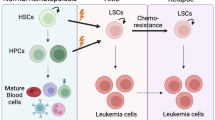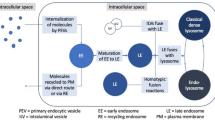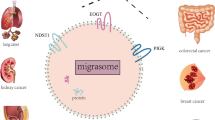Abstract
To elucidate the biological significance of the lactosylceramide (LacCer) branching in glycosphingolipid (GSL) biosynthesis, we established ganglioside GM3- and lactosylsulfatide SM3-reconstituted cells by introducing the GM3 synthase gene and the sulfotransferase gene, respectively. In SM3-expressing cells, the reduction of β1 integrin mRNA expression, the reduced adhesivity to fibronectin and laminin, and the suppression of anchorage-independent growth (tumorigenic potential) were observed. On the other hand, in GM3-expressing cells, anchorage-independent growth was promoted and the expression of PDGFα receptor mRNA was specifically reduced. Interestingly enough, no change in anchorage-dependent growth was observed in these cells, and tumorigenic signals were controlled selectively in both positive and negative directions. Thus, the spatio-temporal, gene expression control mechanism by individual GSL molecules accumulating in the cell membrane microdomain (raft) has been proven. Published in 2004.
Similar content being viewed by others
References
Nagata Y, Yamashiro S, Yodoi J, Lloyd KO, Shiku H, Furukawa K, Expression cloning of beta 1,4 N-acetylgalactosaminyltransferase cDNAs that determine the expression of GM2 and GD2 gangliosides, J Biol Chem 267, 12082-9 (1992).
Ishii A, Ohta M, Watanabe Y, Matsuda K, Ishiyama K, Sakoe K, Nakamura M, Inokuchi J, Sanai Y, Saito M, Expression cloning and functional characterization of human cDNA for ganglioside GM3 synthase, J Biol Chem 273, 31652-5 (1998).
Honke K, Tsuda M, Hirahara Y, Ishii A, Makita A, Wada Y, Molecular cloning and expression of cDNA encoding human 3?-phosphoadenylylsulfate:galactosylceramide 3?-sulfotransferase, J Biol Chem 272, 4864-8 (1997).
Kojima Y, Fukumoto S, Furukawa K, Okajima T, Wiels J, Yokoyama K, Suzuki Y, Urano T, Ohta M, Furukawa K, Molecular cloning and expression of cDNA encoding human 3?-phosphoadenylylsulfate:galactosylceramide 3?-sulfotransferase, J Biol Chem 275, 15152-6 (2000).
Keusch JJ, Manzella SM, Nyame KA, Cummings RD, Baenziger JU, Molecular cloning and expression of cDNA encoding human 3′-phosphoadenylylsulfate:galactosylceramide 3?-sulfotransferase, J Biol Chem 275, 25308-14 (2000).
Togayachi A, Akashima T, Ookubo R, Kudo T, Nishihara S, Iwasaki H, Mio H, Inokuchi J, Irimura T, Sasaki K, Narimatsu H, Molecular cloning and characterization of UDP-GlcNAc: lactosylceramide beta 1,3-N-acetylglucosaminyltransferase (beta 3Gn-T5), an essential enzyme for the expression of HNK-1 and Lewis X epitopes on glycolipids, J Biol Chem 276, 22032-40 (2001).
Inokuchi J, Jimbo M, Kumamoto Y, Shimeno H, Nagamatsu A, Expression of ganglioside GM3 and H-2 antigens in clones with different metastatic and growth potentials isolated from Lewis lung carcinoma (3LL) cell line, Clin Exp Metastasis 11, 27-36 (1993).
Uemura S, Kabayama K, Noguchi, M. Igarashi Y, Inokuchi J, Sialylation and sulfation of lactosylceramide distinctly regulate anchorage-independent growth, apoptosis, and gene expression in 3LL Lewis lung carcinoma cells, Glycobiology 13, 207-16 (2003).
Kabayama K, Ito N, Honke K, Igarashi Y, Inokuchi J, Suppression of integrin expression and tumorigenicity by sulfation of lactosylceramide in 3LL Lewis lung carcinoma cells, J Biol Chem 276, 26777-83 (2001).
Paller AS, Arnsmeier SL, Chen JD, Woodley DT, Ganglioside GT1binhibits keratinocyte adhesion and migration on a fibronectin matrix, J Invest Dermatol 105, 237-42 (1995).
Zheng M, Fang H, Tsuruoka T, Tsuji T, Sasaki T, Hakomori S, Regulatory role of GM3 ganglioside in alpha 5 beta 1 integrin receptor for fibronectin-mediated adhesion ofFUA169 cells, J Biol Chem 268, 2217-22 (1993).
Hyuga S, Yamagata S, Takatsu Y, Hyuga M, Nakanishi H, Furukawa K, Yamagata T, Suppression by ganglioside GD1A of migration capability, adhesion to vitronectin and metastatic potential of highly metastatic FBJ-LL cells, Int J Cancer 83, 685-91 (1999).
Ono M, Handa K, Withers DA, Hakomori S, Glycosylation effect on membrane domain (GEM) involved in cell adhesion and motility: A preliminary note on functional alpha3, alpha5-CD82 glycosylation complex in ldlD 14 cells, Biochem Biophys Res Commun 279, 744-50 (2000).
Claas C, Stipp CS, Hemler ME, Evaluation of prototype transmembrane 4 superfamily protein complexes and their relation to lipid rafts, J Biol Chem 276, 7974-84 (2001).
Fredman P, von Holst H, Collins VP, Dellheden B, Svennerholm L, Expression of gangliosides GD3 and 3′-isoLM1 in autopsy brains from patients with malignant tumors, J Neurochem 60, 99-105 (1993).
Cumar FA, Brady RO, Kolondy EH, McFarland VW, Mora PT, Enzymatic block in the synthesis of gangliosides in DNA virustransformed tumorigenic mouse cell lines, Proc Natl Acad Sci USA 67, 757-64 (1970).
Hakomori S, Glycosphingolipids in cellular interaction, differentiation, and oncogenesis, Annu Rev Biochem 50, 733-64 (1981).
Bremer EG, Schlessinger J, Hakomori S, Ganglioside-mediated modulation of cell growth. Specific effects of GM3 on tyrosine phosphorylation of the epidermal growth factor receptor, J Biol Chem 261, 2334-40 (1986).
Bremer EG, Hakomori S, GM3 ganglioside induces hamster fibroblast growth inhibition in chemically-defined medium: Ganglioside may regulate growth factor receptor function, Biochem Biophys Res Commun 106, 711-28 (1982).
Bremer EG, Hakomori S, Bowen-Pope DG, Raines E, Ross R, Ganglioside-mediated modulation of cell growth, growth factor binding, and receptor phosphorylation, J Biol Chem 259, 6818-25 (1984).
Yates AJ, Brocklin JV, Saqr HE, Guan Z, Stokes BT, O'Dorisio MS, Mechanisms through which gangliosides inhibit PDGFstimulated mitogenesis in intact Swiss 3T3 cells: Receptor tyrosine phosphorylation, intracellular calcium, and receptor binding, Exp Cell Res 204, 38-45 (1993).
Mutoh T, Tokuda A, Miyadai T, Hamagauchi M, Fujuki N, Ganglioside GM1 binds to the Trk protein and regulates receptor function, Proc Natl Acad Sci USA 92, 5087-91 (1995).
Minoguchi K, Swain WD, Berenstain EH, Siraganian RP, Src family tyrosine kinase p53/56lyn, a serine kinase and Fc epsilon RI associate with alpha-galactosyl derivatives of ganglioside GD1b in rat basophilic leukemia RBL-2H3 cells, J Biol Chem 269, 5249-45 (1994).
Kasahara K, Watanabe Y, Yamamoto T, Sanai Y, Association of Src family tyrosine kinase Lyn with ganglioside GD3 in rat brain; Possible regulation of Lyn by glycosphingolipid in caveolae-like domains, J Biol Chem 272, 29947-53 (1997).
Iwabuchi K, Yamamura S, Prinetti A, Hanada K, Hakomori S, Association of Src family tyrosine kinase Lyn with ganglioside GD3 in rat brain. Possible regulation of Lyn by glycosphingolipid in caveolae-like domains, J Biol Chem 273, 9130-8 (1998).
Iwauchi K, Hanada, Hakomori S, Separation of "glycosphingolipid signaling domain" from caveolin-containing membrane fraction in mouse melanoma B16 cells and its role in cell adhesion coupled with signaling, J Biol Chem 273, 33766-73 (1998).
Inokuchi J, Radin NS, Preparation of the active isomer of 1-phenyl-2-decanoylamino-3-morpholino-1-propanol, inhibitor of murine glucocerebroside synthetase, J Lipid Res 28, 565-71 (1987).
Inokuchi J, Momosaki K, Shimeno H, Nagamatu A, Radin NS, Effects of D-threo-PDMP, an inhibitor of glucosylceramide synthetase, on expression of cell surface glycolipid antigen and binding to adhesive proteins by B16 melanoma cells, J Cell Physiol 141, 573-83 (1989).
Inokuchi J, Modulators of glycosphingolipid biosynthesis (PDMP): Application to cell biology, Tannpakushitu Kakusan Kouso 43, 2495-502 (1998).
Inokuchi J, Uemura S, Kabayama K, Igarashi Y, Glycosphingolipid deficiency affects functional microdomain formation in Lewis lung carcinoma cells, Glycoconj J 17, 239-45 (2000).
Katagiri YU, Mori T, Nakajima H, Katagiri C, Taguchi T, Takeda T, Kiyakawa N, Fujimoto J, Activation of Src family kinase Yes induced by Shiga toxin binding to globotriaosyl ceramide (Gb3/CD77) in low density, detergent-insoluble microdomains, J Biol Chem 275, 35278-82 (1999).
Do MS, Fitzer-Attas C, Gubbay J, Greenfeld L, Feldman M, Eisenbach L, Mouse platelet-derived growth factor alpha receptor: Sequence, tissue-specific expression and correlation with metastatic phenotype, Oncogene 7, 1567-75 (1992).
Basu S, Das K, Basu M, in Oligosaccharides in Chemistry and Biology-A Comprehensive Handbook, edited by Ernst B, Sinay P, Hart G (Willey-VCH Verlag GmbH, Germany, 2000), pp. 329-347. Glycosyltransferases in Glycosphingolipid Biosynthesis.
Author information
Authors and Affiliations
Corresponding author
Rights and permissions
About this article
Cite this article
Inokuchi, Ji., Kabayama, K., Uemura, S. et al. Glycosphingolipids govern gene expression. Glycoconj J 20, 169–178 (2003). https://doi.org/10.1023/B:GLYC.0000024248.62242.1f
Issue Date:
DOI: https://doi.org/10.1023/B:GLYC.0000024248.62242.1f




